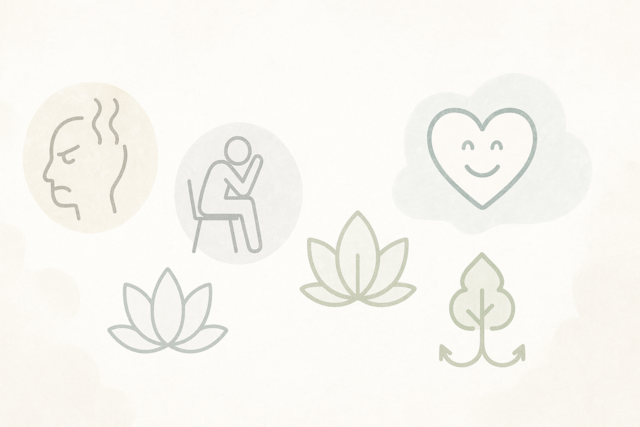NLP � Neuro-Linguistic Programming for Relaxation
-
You CAN Change
-
NLP Reframing
-
Persuade Yourself
NLP, or Neuro-Linguistic Programming, is an approach to changing thoughts and behaviors by setting an "intent" to do so, and then modeling excellence. What does that mean? Simply that by thinking about the perfect way to do something, your brain begins firing in such a way that it believes that you are actually practicing to do something perfectly.
NLP was developed in the early 1970s by John Grinder and Richard Bandler at UC Santa Cruz. Grinder was a professor of linguistics who studied the connections between language, the mind, and behavior. Bandler was a math and computer student who had the key NLP skill we call "modeling." As they worked together, they studied therapists in their psychotherapy practices because they noticed that some therapists were especially successful with their patients. What they learned is that if they taught others to "model" or imitate the behaviors and techniques of these particularly effective therapists, others could learn to achieve excellence as well.
NLP is, therefore, modeling excellence. It is a technique that is used from Olympic athletes to high-powered corporate CEOs who know that to win in this world, they must be the best that they can be.
By modeling excellence, you can achieve excellence. Because there are people who have been able to do something especially well means that by modeling their behaviors, or even your own when you do something especially well, you will begin to retrain your thoughts away from fear and failure, toward success and achievement.
What does this have to do with relaxation? Absolutely everything. You are in the midst of learning many techniques to help you with your goal of learning to relax. By being mindful about everything you do, you will have begun to notice when things begin to bother you, increasing your stress levels. By merely noticing, you can either halt the stress response, or even better, bring your levels back down to a state of relaxation.
What you will learn in this article is how to use specific NLP techniques in order to model excellence as it applies to relaxation.
You CAN Change
NLP is sometimes seen as another form of self-hypnosis. This can certainly be true, especially when you practice self-hypnosis with the purpose of modeling excellence, which is what NLP is all about. The most important thing in NLP is your mindset, that you believe that you can change. Once you believe that you will change, then all your practice will further support that belief making it a stronger response than even fear or stress.
Let's break down Neuro-Linguistic Programming just a little bit further to reveal how using NLP techniques will work with your relaxation process.
Neuro � Refers to our nervous system which includes our brain, nerves, axions, etc. This portion refers to how our body responds to our experiences. Say you touch a hot stove: Your nervous system will pull your hand away even before your brain has a chance to tell you, "That's hot!" So how you feel depends on how your nervous system processes your experiences.
Linguistic � Refers to language and how symbols, like words, affect us. When we work to change our behavior, we use words to affect our nervous system in order to change.
Programming � This word is used because NLP uses symbols and experiences to program ourselves to achieve excellence. We can program our brain/nervous system to respond to stress in a proactive and productive way rather than in an out-of-control, destructive way. By using NLP we can improve the way we respond to all events in our life, by actually programming ourselves to respond differently to various stimuli.
NLP begins with "setting an intent." This means that you choose what you want the outcome to be. Because it is impossible to teach you everything there is to know about NLP in a single article, we will focus on two NLP techniques that relate specifically to reducing stress and anxiety about situations.
Many people report having experienced something in their past that they still feel guilty about, or small, or humiliated, or afraid, or anxious. These experiences can continue to color how we perceive new experiences if we do not take steps to change our response to the memory.
Reframing is an excellent NLP technique that helps to change our response to such a memory, and as a result, changes our response to any new situation that would tap into that memory, and the subsequent feelings and emotions that overpower us.
We'll start, first by defining "framing." Framing is how we perceive something, and what we think our choices are about in that situation. As an example, let's say Larry wants a raise. His expenses keep increasing, and pretty soon, Larry isn't going to have enough money to handle all of his day-to-day expenses, much less save anything for the future.
Every time Larry thinks about going into his boss's office to ask for a raise, he flashes back to a previous experience in his teens where he once asked for an advance on his paycheck. That former boss insulted and humiliated Larry to the point that he was nearly in tears after the encounter.
Because of that encounter, every time Larry thinks about asking for a raise, the experience returns to his mind, his emotions rise almost to the same level they did with the original encounter, even though it was years ago. His heart begins beating faster, he flushes, his blood pressure goes up, his breathing becomes shallow, he's deep in the effects of stress.
The interesting things about this example, however, is that the event is not happening right now. However, because Larry has never worked to get rid of this limiting belief about himself, it impacts his life in a powerful, but negative way.
In order to reframe this experience, the first thing Larry needs to do is to become aware of his response to the memory. As Larry sits quietly, thinking about the memory, he allows it to come to him in the manner it usually does, and as he's remembering, Larry will notice whether he is "in" his memory, or if he sees himself as "watching" the event happen.
If you are "in" the memory, you are reliving it over and over again. This is considered to be an "associative" state.
In order to take the first step in reframing, Larry will now pull back in his mind, watching the image of the event move a little farther and farther away from him. Pretty soon, Larry will begin to feel as if he were in a theater watching a movie. He no longer sees the situation from inside himself, he has removed himself and is now watching the event from a distance.
Simply by removing himself from the immediacy of the event, Larry can begin to lessen the impact this memory has on him. Some NLP practitioners suggest imagining a frame around the picture now that Larry is no longer "associated" with the memory. He has now "dissociated" himself from it.
Now, Larry will consciously frame that memory, and then move it farther and farther from himself, so that the image becomes smaller and smaller. He can the test himself and bring the image closer, and test how he is feeling.
After practicing this for a bit, Larry will take a moment to check and see how he feels. Practicing a few deep-breathing exercises is a good idea at this point. Then, return to the memory of the picture. Larry's feelings have probably changed. If they are still too painful for him to try to approach his boss, Larry can continue to practice this technique until he discovers that his feelings have changed significantly with regard to the old event.
Then, Larry will check how he feels in an hour, then in a couple of hours. Check it again in a day, then a week later. What Larry and you will find is that your memory of that incident that bothered you will stay changed, because you used the way your brain encodes memories and information to make that change.
It seems simple.
It doesn't require weeks of repeating affirmations. It doesn't require months of psychotherapy. By taking an event that has troubled or hurt you in the past, and reframing it with this technique, you will have managed to exert a power over it that you never had before. This is a simple, yet incredibly powerful technique. And it is only one of thousands of NLP techniques you could try to use to reduce your stress and anxiety in your day-to-day living.
Persuade Yourself
Persuade yourself that you can excel at something. In this case, you will excel at relaxation. One important thing about NLP is to model behavior that you want to adopt, not thinking about behavior you wish you could change. This is a positive modeling process.
Let's consider world-class star athletes. They will review film footage or video of either their performances or that of their opponents, whichever provides the most positive model for their desired outcome.
A downhill skier will watch a film or video of a perfect run from start to finish over and over and over and over. Star athletes admit to watching film and videos in this manner, sometimes as many as a thousand times.
Why do they do this?
They are embodying the very essence of NLP, which is the act of modeling perfection. Our brain does not know that we are not physically performing the activity as long as we put ourselves in the mindset of performing the activity.
Studies have taken athlete, and hooked them up to hundreds of sensors that measure the response of their muscles, from the slightest twitch to a gross movement. By putting yourself in the position of actually performing an activity perfectly, and watching it over and over and over, your brain believes that you have practiced that activity perfectly hundreds of time.
What happens with that kind of practice? You get better at what you do. You get a lot better at what you do!
Professional boxers and golfers routinely improve their performance in this manner. Ian Woosnam MBE, was the world's top-ranked golfer in 1991. He used NLP techniques to help him to attain that elite level of golfing ability. British cycling star Chris Hoy used NLP visualization to take Britain to the top at the Beijing Olympics. Morten Gamst Pedersen uses NLP to improve his free-kicks. Former world middleweight champion boxer Nigel Benn used NLP.
Here's how you can do this without necessarily filming yourself handling a stressful confrontation perfectly. First, it would seem very contrived and you will know that; second it isn't necessary. Your brain is the most powerful computer on the planet and once you know how to harness its power, this will become a very simple exercise.
Think about the last time you had a conversation with someone that didn't go well, or perhaps you have to do a sales pitch in front of a room full of skeptical buyers. Have you ever practiced a sales pitch by imagining it in your head? You probably have, but have never admitted it to anyone because you thought perhaps you were acting a little crazy.
Here's a secret: All the successful salespeople who use this technique will tell you that it works!
You say, "But I've done that, and it didn't work!"
While you may have done this, what you may not have done is to repeat it over and over and over, envisioning an excellent outcome. Remember, the more times you repeat the activity, the more solidly cemented it becomes in your brain.
Now, set aside 15 to 20 minutes every day, from now until the event, and visualize yourself conducting the required behavior perfectly, no mistakes, no fear, no stress, no uncomfortable feelings.



























